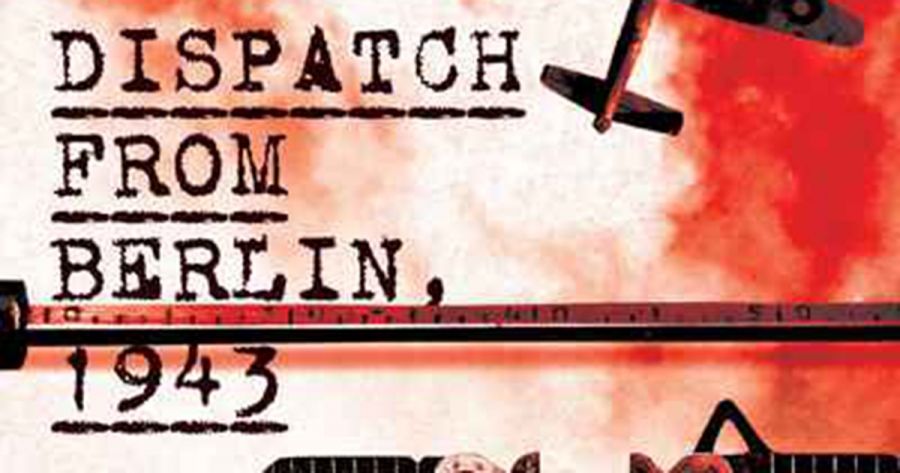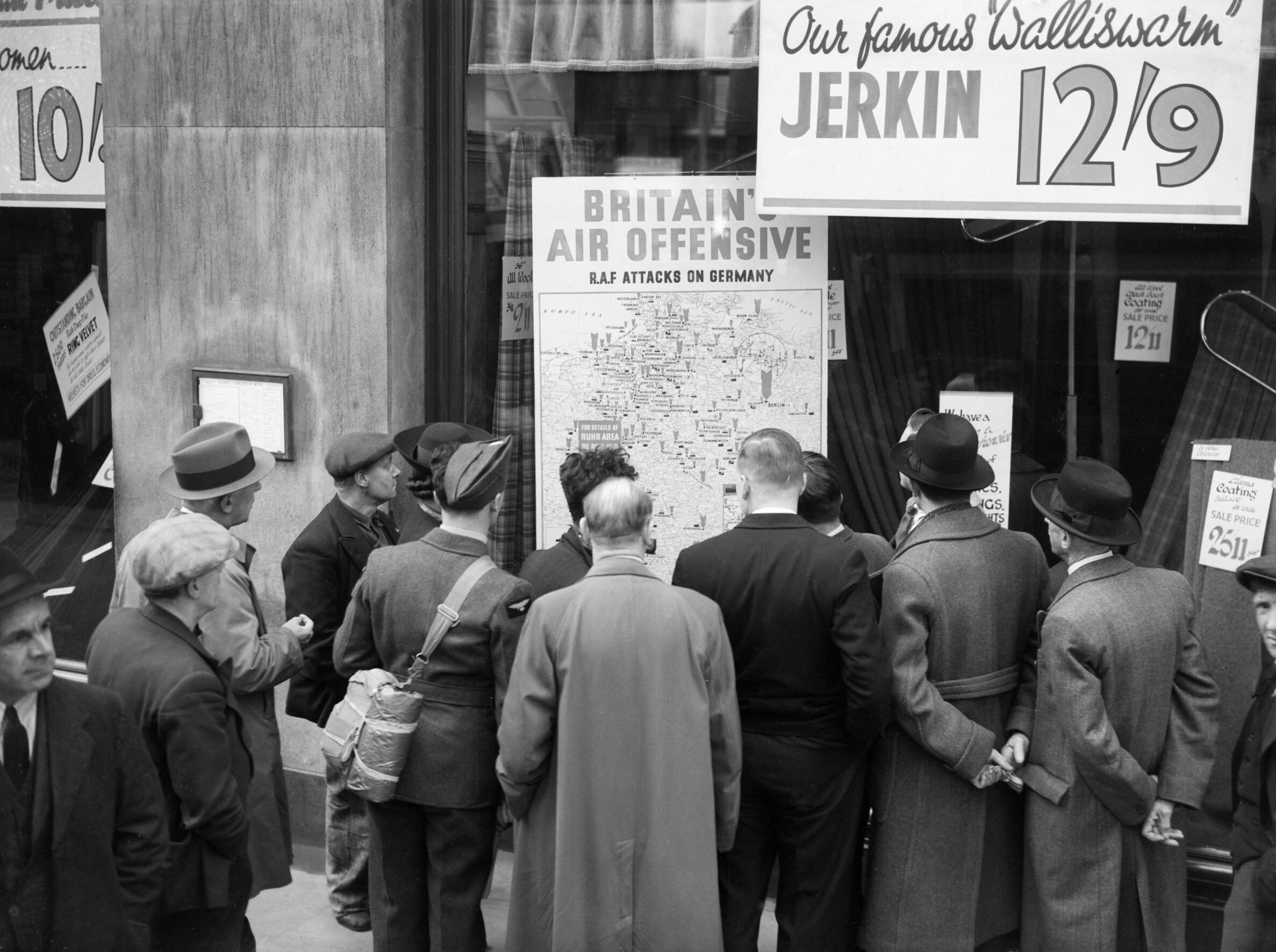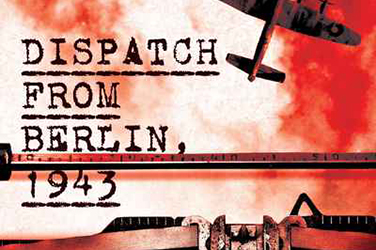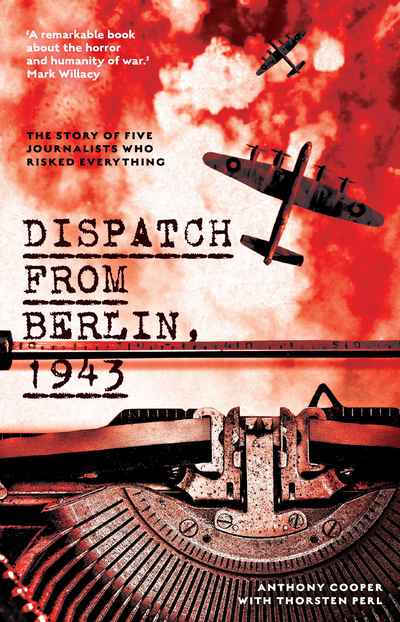
- Free Article: No
- Contents Category: History
- Review Article: Yes
- Article Title: ‘And yet more fire’
- Article Subtitle: The bombing of Berlin
- Online Only: No
- Custom Highlight Text:
Bomber Command operations cost about 3,500 Australian lives in World War II. This was more than five times the number of Australians who died in the Battle of Kokoda from July to November 1942. Yet the strategic bombing offensive over Germany has never held a comparable place in the national memory of war.
- Article Hero Image (920px wide):

- Article Hero Image Caption: A British airman is among a group of civilians crowded around the window of a shop in Holborn, London, to look at a map illustrating how the RAF is striking back at Germany during 1940 (D1254 Imperial War Museum/Ministry of Information Photo Division Photographer via Wikimedia Commons)
- Featured Image (400px * 250px):

- Alt Tag (Featured Image): Joan Beaumont reviews 'Dispatch from Berlin, 1943: The story of five journalists who risked everything' by Anthony Cooper, with Thorsten Perl
- Book 1 Title: Dispatch from Berlin, 1943
- Book 1 Subtitle: The story of five journalists who risked everything
- Book 1 Biblio: NewSouth, $34.99 pb, 344 pp
- Book 1 Cover Small (400 x 600):

- Book 1 Cover (800 x 1200):

Anthony Cooper’s Dispatch from Berlin, 1943 does not aim to resolve these questions. But it makes riveting reading for different reasons. It tells the enthralling story of five journalists who accepted the invitation of the British Air Ministry to take a seat on an RAF four-engine Lancaster bomber while it conducted a raid in the Battle of Berlin, a concentrated air campaign launched against the German capital from November 1943 to late March 1944. Two of the reporters were Australian: Alfred King, the senior correspondent in the London office of The Sydney Morning Herald; and Norm Stockton, also based in London. The Americans were the pioneering radio broadcaster Ed Murrow and a young war correspondent, Lowell Bennett. The fifth place was taken by a distinguished Norwegian writer and patriotic radio broadcaster in exile, Nordahl Grieg.
All of these men knew the risks they were taking, but it seems that their self-esteem and desire for professional authenticity persuaded them to go ‘where the action was’. Not all of them would survive.
With skilful writing and attention to detail (much of it the result of years of Thorsten Perl’s research), Cooper integrates the vivid accounts left by these journalists with data about Bomber Command and the technicalities of air navigation. He provides an unforgettable account of the raid on Berlin on 2 December 1943. We almost feel the claustrophobia of the Lancaster’s interior; the discomfort of the heavily harnessed and padded journalists, who stood for the whole flight wedged behind the pilot; the terror of flying through a torrent of flak and German fighter attacks above Berlin; and the shock of parachuting from a flaming or exploding plane into the cold winter night. It was a ‘demented theatre of light and flame’. Only ten per cent of Lancaster aircrew escaped alive from shot-down aircraft.
For the German population on the ground, the experience was even worse. In this five-raid series of attacks over Berlin, the RAF dropped 475 ‘blockbuster’ bombs, 3,000 smaller high-explosive bombs, and 770,000 incendiaries. An estimated 4,500 Germans were buried in the rubble of collapsed buildings; only 1,202 were dug out alive. One Berliner, caught without shelter during a raid when heading home from the opera in Charlottenburg, recalled, ‘Everywhere I looked there was nothing but fire, fire and yet more fire.’
Remarkably, in a chapter devoted to the dead, Cooper shows that the bodies of the Allied airmen who rained from the sky were identified and buried with respect, although the sheer number of aircrew lost in the Berlin raids and the chaos in the city itself created administrative difficulties in recording the number of burials.
Berlin, it should be remembered, was only one of many cities that were laid waste in 1943. Bennett, who parachuted to earth and was taken prisoner, was given a grand tour of several devastated cities in an effort by German authorities to convert him to write pro-German articles. What he saw suggested that the industrial suburbs had been left relatively undamaged, whereas the civilian precincts were shattered. Bennett’s impressions are left to speak for themselves, and Cooper does not venture into the debate as to whether the British deliberately targeted civilians. He does, however, provide evidence from post-operations reports that the aircrew measured the success of their raids by the scale of the conflagration they generated on the ground.
Cooper also documents how difficult British bombers found it to stick to their prescribed flight paths during the Berlin raids. This is critical to the moral debate about the bombing offensive. The justification for area bombing at this stage of the war was that the British could not bomb precisely enough to differentiate between civilian and military targets. The best way they could damage Germany – and demonstrate to their Allies that the British were carrying their weight in the war – was to bomb industrial cities and ‘dehouse’ the workers who were integral to the war effort.
However, it is incontestable that strategic bombing also targeted civilians. The commander-in-chief of Bomber Command, Arthur Harris, said as much at the time. Few people in Britain felt much compassion for the enemy who had bombed Warsaw, Rotterdam, London, Coventry, and countless other cities. The morality of area bombing was only widely questioned in 1945 when more precise bombing was possible, yet Harris kept pulverising German cities – including Dresden, a jewel of baroque architecture, the ‘Florence of the Elbe’.
No reader will finish this book without asking: was the strategic bombing offensive worth it? Despite the death of 600,000 German citizens, German morale did not collapse. The victims of bombing did not rise up to overthrow Hitler. Most significantly, German industry adapted and dispersed under bombardment. Until the last months of the war, German production increased with an effectiveness that allowed the armed forces to continue fighting forlorn campaigns well into 1945. Of course, it can be argued that that increase would have been greater had the Germans not had to divert huge resources into defensive rather than offensive purposes.
The debate about the contribution of strategic bombing as a whole to Germany’s defeat will presumably continue. But few would argue that the Battle of Berlin itself, which forms the centrepiece of this book, was a victory, so huge were the losses of aircraft and men. This invests with a particular poignancy this story, not just of the journalists who risked one mission, but also the young aircrew who flew over Germany time and again knowing the ‘orchestrated hell’ that awaited them.


Comments powered by CComment